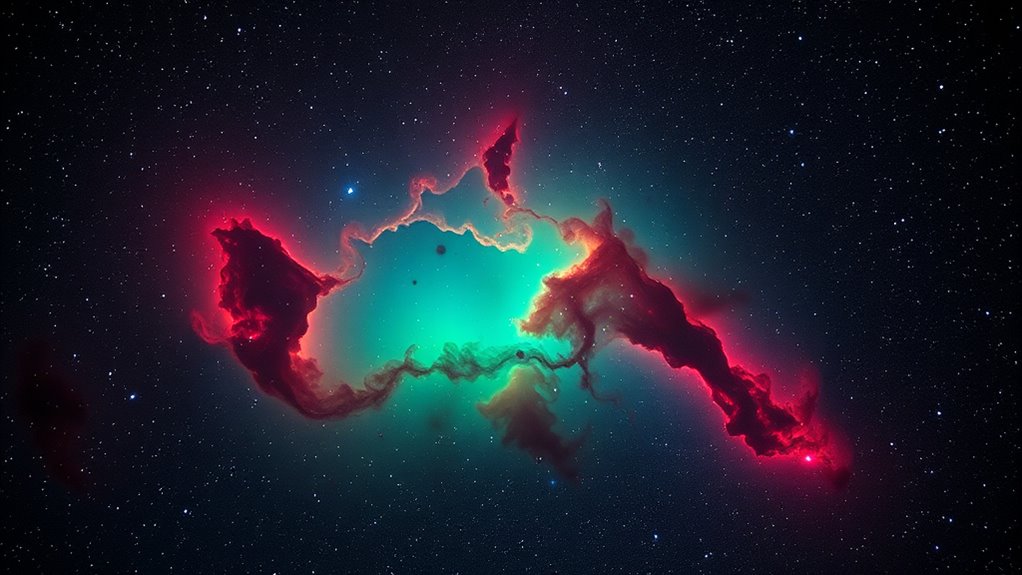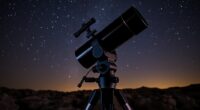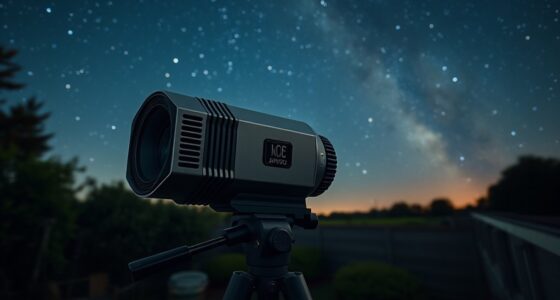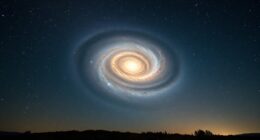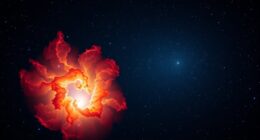If you’re after stunning astrophotos, I recommend checking out the top seven Askar narrowband filters. These include duo-band options like the Ultra E2 and Super D2, which isolate key emission lines such as OIII, SII, and Hα with high transmittance. They’re great for enhancing faint details and reducing light pollution, even from urban areas. If you keep exploring, I’ll guide you through what makes each filter special and how to choose the best one for your setup.
Key Takeaways
- Askar offers high-transmittance dual-band filters (over 85%) ideal for capturing emission lines like Hα, OIII, and SII.
- Models such as the Colour Magic Ultra E2 and Super D2 enhance nebula and galaxy imaging in light-polluted areas.
- The 2-inch size ensures compatibility with standard filter wheels and telescope setups for versatile use.
- Precise bandwidths (e.g., 3-8.5nm) optimize emission line isolation, improving image contrast and detail.
- Their lightweight, easy-to-install design makes them suitable for both amateur and professional astrophotographers aiming for stunning results.
Askar Colour Magic Ultra E2 Narrowband Duo-Band Filter (OIII+SII)
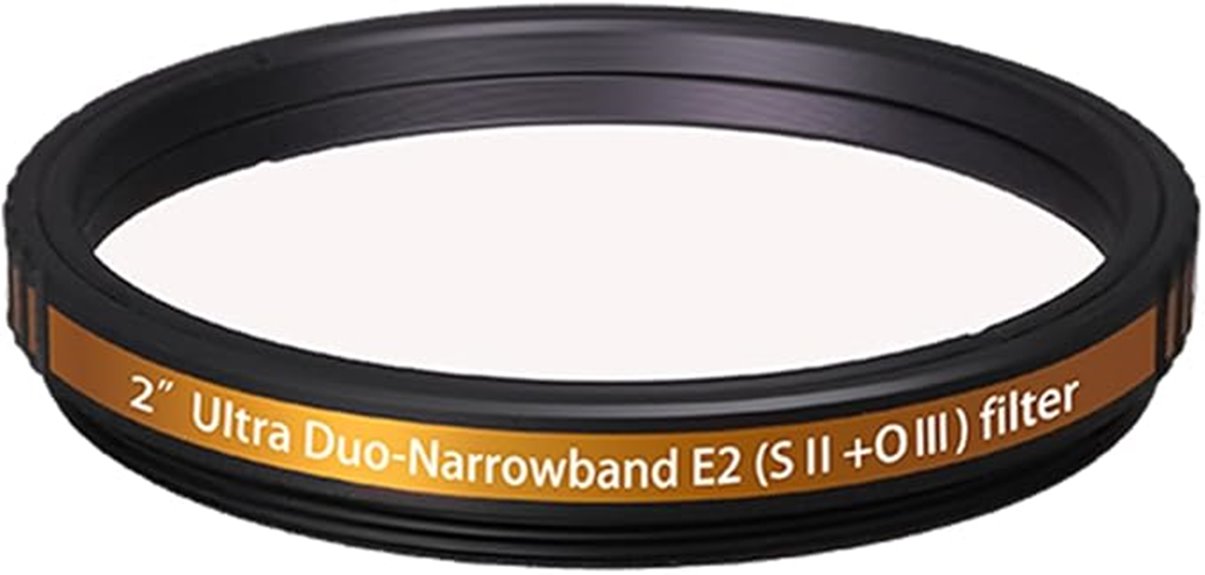
If you’re serious about deep-sky astrophotography, the Askar Colour Magic Ultra E2 Narrowband Duo-Band Filter (OIII+SII) is a top choice because it effectively enhances nebula and galaxy images by filtering specific emission lines. Its duo-narrowband design, including traditional Hα+OIII and innovative SII+OIII options, boosts contrast and reveals faint details. With over 85% transmittance at key wavelengths, it reduces light pollution and improves image clarity. Suitable for both color and mono cameras, this filter helps you capture stunning celestial structures even in heavily polluted areas, making it an essential tool for dedicated astrophotographers.
Best For: serious astrophotographers seeking to enhance deep-sky imaging by effectively filtering emission lines and reducing light pollution in both color and mono camera setups.
Pros:
- Excellent high transmittance exceeding 85% at key wavelengths (OIII and SII) for bright, clear images.
- Duo-narrowband design offers versatile imaging options, including traditional Hα+OIII and innovative SII+OIII filters.
- Significantly reduces light pollution, making it ideal for astrophotography in heavily polluted areas.
Cons:
- May require precise focusing and calibration due to narrow bandwidth to achieve optimal results.
- Limited to 2-inch size, which may not fit all telescope filter slots or setups.
- Higher cost compared to standard single-band filters, potentially limiting accessibility for casual users.
Askar Colour Magic Super D Filter Package

The Askar Colour Magic Super D Filter Package stands out as an excellent choice for astrophotographers seeking to enhance their imaging with minimal light pollution interference. It includes D1 (Ha+OIII) and D2 (SII+OIII) filters, both with 2-inch diameters, making them versatile for various telescopes. These filters appreciably boost contrast and reduce light pollution, helping you capture clearer, more detailed images of celestial objects. Weighing just under three ounces, they’re easy to handle and install. Available since late 2023, they’re highly rated for performance and customer support, making them a reliable addition to any astrophotography setup.
Best For: astrophotographers and astronomy enthusiasts looking to improve image contrast and reduce light pollution in their celestial observations.
Pros:
- Enhances contrast and image clarity for astrophotography
- Reduces light pollution, enabling clearer images of celestial objects
- Compact and lightweight design for easy handling and installation
Cons:
- Limited to telescope filters with 2-inch diameter, may not fit all setups
- Only includes D1 (Ha+OIII) and D2 (SII+OIII) filters, which may require additional filters for other imaging needs
- Slightly higher price point compared to basic filters, but justified by performance and quality
10.7M Narrowband Bandpass Filter 2017F Intermediate Frequency Filter

Are you searching for a reliable filter to isolate signals around 10.7 MHz with precision? The 10.7M Narrowband Bandpass Filter 2017F is designed for that purpose. It’s an intermediate frequency filter that effectively filters specific narrow frequency bands, ensuring clear signal processing. Whether you’re working on communication systems or signal analysis, this filter helps you focus on signals precisely at 10.7 MHz. Its robust design and focus on this particular frequency make it a dependable choice. If you need accurate filtering at this frequency, the 2017F provides consistent performance suited for various intermediate frequency applications.
Best For: professionals and engineers working on communication systems or signal analysis requiring precise filtering at 10.7 MHz.
Pros:
- Provides accurate and reliable filtering at 10.7 MHz
- Designed specifically for intermediate frequency applications
- Robust construction ensures durability and consistent performance
Cons:
- Limited to narrowband filtering at 10.7 MHz, not suitable for wider frequency ranges
- May require specialized knowledge for optimal integration into systems
- Potentially higher cost compared to general filters due to specialized design
Askar Colour Magic C2 Duo-Band Filter for Astrophotography

Designed for astrophotographers seeking enhanced contrast and detail, the Askar Colour Magic C2 Duo-Band Filter excels at capturing nebulae even in light-polluted skies. With transmittance exceeding 90% at 500.7nm (SII) and 672nm (OIII), it sharply improves image quality by darkening the sky background and boosting contrast. This filter effectively filters out artificial light pollution, streetlights, and natural sources, allowing nebulae details to stand out clearly. Its dual-band design simplifies post-processing and makes it ideal for both observation and astrophotography. Overall, it’s a versatile, user-friendly tool that markedly elevates imaging in challenging conditions.
Best For: amateur and professional astrophotographers seeking to enhance nebula imaging in light-polluted environments with high contrast and detail.
Pros:
- High transmittance exceeding 90% at key emission lines for clear, detailed images
- Effectively reduces light pollution, improving contrast in challenging conditions
- Dual-band design simplifies post-processing and enhances ease of use
Cons:
- May require compatible filter wheel or mount adjustments for optimal performance
- Limited to specific wavelengths, so not suitable for all astronomical objects
- Can be relatively expensive compared to single-band filters
Askar Colour Magic C 2 Duo-Band Filter Set for Astrophotography

If you’re looking to elevate your astrophotography, the Askar Colour Magic C 2 Duo-Band Filter Set is a top choice for capturing stunning images of nebulae and gaseous objects. It features filters that transmit over 90% of light at key emission lines, including O-III at 500.7nm and S-II at 672nm. These filters enhance contrast by darkening the sky background and boosting star detail, even in light-polluted areas. The dual-band design simplifies setup by blocking nearly all other wavelengths, reducing post-processing. Perfect for both observation and imaging, this set delivers high clarity and sharpness, making detailed celestial features more accessible.
Best For: amateur and professional astrophotographers seeking to capture high-contrast images of nebulae and gaseous celestial objects in light-polluted environments.
Pros:
- Enhances contrast and image clarity by darkening the sky background.
- Transmits over 90% of light at key emission lines, ensuring bright, detailed images.
- Simplifies setup with dual-band design, reducing post-processing time.
Cons:
- May require compatible camera and telescope filters for optimal performance.
- Limited to specific emission lines; not suitable for all celestial objects.
- Cost could be higher compared to single-band filters for casual observers.
Askar Colour Magic Super D2 Duo Narrowband Filter (OIII&SII)

The Askar Colour Magic Super D2 Duo Narrowband Filter (OIII & SII) stands out as an excellent choice for astrophotographers seeking to capture vibrant deep-sky objects while minimizing light pollution. Its precise 6.5nm and 8.5nm bandwidths effectively enhance contrast and isolate emission lines from nebulae, resulting in vivid images. With a peak transmittance of 85%, it guarantees bright, clear details. Compatible with 2-inch telescopes, this lightweight filter is easy to handle. Since its release in March 2024, it has earned a perfect 5-star rating, making it a reliable tool for those aiming for stunning astrophotography with minimal light interference.
Best For: astrophotographers seeking to capture detailed, vibrant deep-sky images while effectively reducing light pollution with a high-transmittance, narrowband filter.
Pros:
- Enhances contrast and isolates nebula emission lines for vivid imaging
- Effectively blocks light pollution, improving image clarity
- Compatible with 2-inch telescopes and lightweight for easy handling
Cons:
- Narrow bandwidth may require longer exposure times for faint objects
- Premium cost could be a consideration for budget-conscious users
- Limited to specific emission lines (OIII & SII), not suitable for all astrophotography needs
Askar Colour Magic Super D1 Duo Narrowband Filter (OIII & Ha)
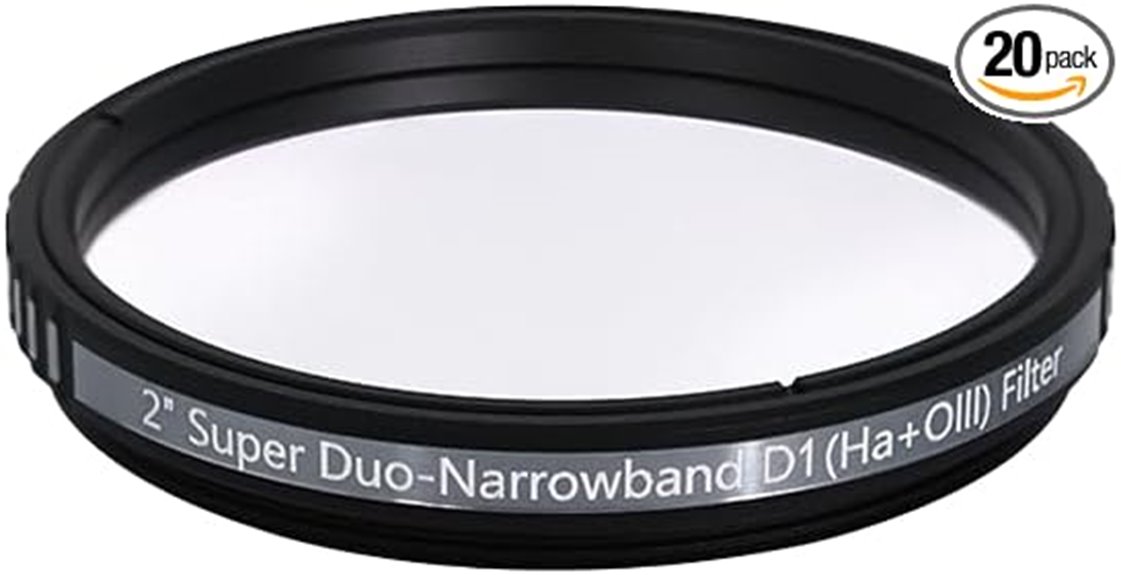
For astrophotographers seeking to capture stunning images of deep-sky objects, the Askar Colour Magic Super D1 Duo Narrowband Filter (OIII & Ha) stands out as an excellent choice. This 2-inch filter effectively enhances contrast and reduces light pollution, allowing celestial details to shine through. With a narrow bandwidth of 6.5nm for OIII and 8.5nm for Ha, it ensures precise filtering of these emission lines, resulting in clearer, more vibrant images. Its high peak transmittance of 85% maximizes light throughput, making it ideal for both deep-sky astrophotography and visual observation. Its compact design and lightweight construction make it versatile and easy to use.
Best For: amateur and professional astrophotographers seeking to capture high-contrast, detailed images of deep-sky objects while effectively reducing light pollution.
Pros:
- Enhances contrast and detail in astrophotography images
- Reduces light pollution for clearer sky observations
- High peak transmittance of 85% maximizes light throughput
Cons:
- Narrow bandwidth may require precise focusing during imaging
- Physical dimensions may necessitate compatible filter slots or holders
- Slightly heavier than some compact filters, which could impact mounting options
Factors to Consider When Choosing the Askar Narrowband Filter

When choosing an Askar narrowband filter, I focus on compatibility with my telescope’s wavelength range and the filter’s bandwidth precision to guarantee clear imaging. I also consider how well it reduces light pollution and whether the size fits my setup. Finally, I look for features that enhance image quality and ease of use to get the best results.
Wavelength Compatibility
Choosing the right Askar narrowband filter starts with ensuring its central wavelength matches the specific emission lines of your target objects. For example, if you’re imaging nebulae rich in oxygen, look for a filter centered around 500.7nm for OIII. For hydrogen-alpha regions, a filter around 656.6nm is ideal. It’s crucial to verify that the filter’s wavelength range aligns with the spectral features of your target, ensuring maximum light transmission. Additionally, check that the filter’s spectral sensitivity complements your camera’s capabilities to avoid losing detail. Compatibility in wavelength helps you effectively isolate the emission lines, resulting in clearer, more vibrant images. By focusing on wavelength compatibility, you’ll optimize your setup for stunning astrophotography of nebulae, galaxies, and other celestial objects.
Bandwidth Precision
How precisely your narrowband filter’s bandwidth is controlled can make all the difference in astrophotography. Narrowband filters usually have bandwidths between 3nm and 8nm, with narrower options providing better spectral isolation. This precision lets the filter target specific emission lines like OIII, Hα, and SII, while reducing background light and light pollution. A bandwidth around 3nm is ideal for capturing faint nebula details without sacrificing contrast. Even slight variations, such as ±0.5nm, can critically affect the filter’s ability to differentiate closely spaced spectral lines, impacting image quality. Higher spectral precision enhances contrast and detail, especially in light-polluted environments. As a result, paying close attention to bandwidth control ensures you get clear, detailed astrophotos with minimal interference.
Light Pollution Reduction
Have you ever struggled to capture faint nebulae in a brightly lit sky? Narrowband filters like those from Askar excel at reducing light pollution by blocking artificial sources such as streetlights and city glow. They selectively transmit emission lines like OIII, SII, and Hα, which are common in nebulae, allowing more of the celestial signal to pass through. With high transmittance rates often above 85%, these filters preserve detail while filtering out unwanted wavelengths. This dramatically improves contrast and clarity, even in heavily light-polluted environments. Using an Askar narrowband filter, you can capture stunning deep-sky images from urban or suburban areas where natural darkness is limited. They’re invaluable tools for astrophotographers seeking vibrant, detailed images despite challenging lighting conditions.
Filter Size & Compatibility
Selecting the right filter size and guaranteeing compatibility with your equipment are key steps in optimizing your astrophotography setup. First, match the filter size to your telescope’s filter thread or mounting system, typically 2 inches for most narrowband filters. Verify that the filter is compatible with your camera type, whether it’s color or mono, to get the best results. Consider the filter’s diameter to prevent vignetting or obstructions, especially if you’re using a filter wheel or holder. It’s also important to check your telescope’s optical specifications—aperture and focal length—to ensure the filter size suits your setup. Larger filters, like 2 inches, offer more coverage and flexibility but might need additional adapters, so plan accordingly.
Imaging Enhancement Features
When choosing an Askar narrowband filter, it’s crucial to consider its imaging enhancement features that directly impact your astrophotography results. These filters excel by isolating specific emission lines like OIII, SII, and Hα, notably boosting contrast and revealing fine details of deep-sky objects. With high transmittance rates exceeding 85%, they maximize light throughput while blocking unwanted wavelengths, which means brighter, clearer images. Optimized bandwidths around 3nm to 8.5nm allow precise spectral filtering, capturing faint nebulae and galaxy structures with minimal light pollution interference. Duo-band options combine two emission lines for thorough coverage, enhancing nebula visibility. Designed to work with both color and mono cameras, these features ensure you get sharper, more detailed astrophotos regardless of your equipment setup.
Ease of Use
Ease of use is a key factor when choosing an Askar narrowband filter, especially for those new to astrophotography or working in less-than-ideal conditions. These filters are designed to block out most light pollution, making them perfect for urban environments. Their high transmittance rates, often over 85%, enable bright, clear images with minimal adjustments during setup. Dual-band filters simplify the process further by blocking nearly all other wavelengths, reducing the need for complex post-processing. Most Askar filters are 2 inches in size, ensuring compatibility with standard telescope accessories and straightforward installation. Their optimized spectral bandwidths, around 3-8nm, allow for precise filtering with minimal tuning, making them accessible and user-friendly for both beginners and experienced astrophotographers alike.
Frequently Asked Questions
How Do Askar Filters Compare to Other Brands in Astrophotography?
Askar filters stand out for their excellent quality and affordability compared to other brands. I’ve found they deliver sharp, contrast-rich images that rival higher-end options. While some premium brands may offer slightly better coatings or durability, Askar’s narrowband filters are reliable and produce stunning astrophotos without breaking the bank. Overall, I think they’re a fantastic choice for enthusiasts seeking high performance at a reasonable price.
What Is the Ideal Exposure Time With Askar Narrowband Filters?
The ideal exposure time with Askar narrowband filters is like tuning a fine instrument—you want just enough to bring out the celestial symphony without overexposing. Typically, I shoot between 10 to 30 minutes per sub-exposure, depending on the target and sky conditions. I often stack multiple shorter exposures to enhance detail and reduce noise, ensuring the nebulae and galaxies shine with clarity and vibrant color.
Can Askar Filters Be Used With Various Telescope Types?
Yes, I can use Askar filters with various telescope types. They’re versatile and compatible with most standard telescope mounts and camera setups. I’ve personally used them with refractors, SCTs, and Newtonians, and they work great across the board. Just guarantee your filters fit your camera or telescope’s optical path. This flexibility makes Askar filters a fantastic choice for different astrophotography setups, allowing me to capture stunning images regardless of my equipment.
How Do Temperature Changes Affect Askar Filter Performance?
Temperature changes can affect askar filter performance by causing slight shifts in their optical properties. When it gets colder or warmer, the filter’s coatings might expand or contract, potentially altering their narrowband capabilities or causing minor shifts in wavelength transmission. I recommend allowing your filters to acclimate to the outdoor temperature before shooting to maintain peak performance and get the clearest, most accurate astrophotos.
Are Askar Filters Suitable for Deep-Sky Astrophotography Beginners?
Think of Askar filters as the artist’s finest brushes—precise and powerful. They’re absolutely suitable for deep-sky astrophotography beginners, offering a clear window into the cosmos. These filters help isolate specific wavelengths, making faint nebulae and galaxies stand out against the darkness. I’ve found them to be user-friendly and effective, turning novice attempts into stunning celestial portraits. If you’re starting out, Askar filters could be your cosmic paintbrushes.
Conclusion
Choosing the right Askar narrowband filter feels like finding a hidden gem in a vast universe. It’s the perfect blend of science and art—precision meets passion. While some filters excel in capturing vibrant colors, others shine in revealing subtle details. Whether you’re chasing breathtaking nebulae or crisp star fields, remember, the best filter isn’t just about specs; it’s about enhancing your unique astrophotography journey. After all, every shot is a small step toward the cosmos’s grand masterpiece.
